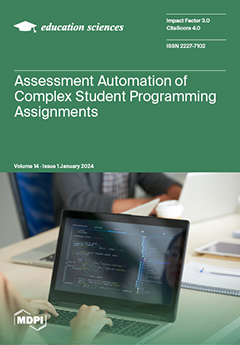Open AccessArticle
Seeing Eye to Eye? Comparing Faculty and Student Perceptions of Biomolecular Visualization Assessments
by
Josh T. Beckham, Daniel R. Dries, Bonnie L. Hall, Rachel M. Mitton-Fry, Shelly Engelman, Charmita Burch, Roderico Acevedo, Pamela S. Mertz, Didem Vardar-Ulu, Swati Agrawal, Kristin M. Fox, Shane Austin, Margaret A. Franzen, Henry V. Jakubowski, Walter R. P. Novak, Rebecca Roberts, Alberto I. Roca and Kristen Procko
Viewed by 1339
Abstract
While visual literacy has been identified as a foundational skill in life science education, there are many challenges in teaching and assessing biomolecular visualization skills. Among these are the lack of consensus about what constitutes competence and limited understanding of student and instructor
[...] Read more.
While visual literacy has been identified as a foundational skill in life science education, there are many challenges in teaching and assessing biomolecular visualization skills. Among these are the lack of consensus about what constitutes competence and limited understanding of student and instructor perceptions of visual literacy tasks. In this study, we administered a set of biomolecular visualization assessments, developed as part of the BioMolViz project, to both students and instructors at multiple institutions and compared their perceptions of task difficulty. We then analyzed our findings using a mixed-methods approach. Quantitative analysis was used to answer the following research questions: (1) Which assessment items exhibit statistically significant disparities or agreements in perceptions of difficulty between instructors and students? (2) Do these perceptions persist when controlling for race/ethnicity and gender? and (3) How does student perception of difficulty relate to performance? Qualitative analysis of open-ended comments was used to identify predominant themes related to visual problem solving. The results show that perceptions of difficulty significantly differ between students and instructors and that students’ performance is a significant predictor of their perception of difficulty. Overall, this study underscores the need to incorporate deliberate instruction in visualization into undergraduate life science curricula to improve student ability in this area. Accordingly, we offer recommendations to promote visual literacy skills in the classroom.
Full article
►▼
Show Figures





